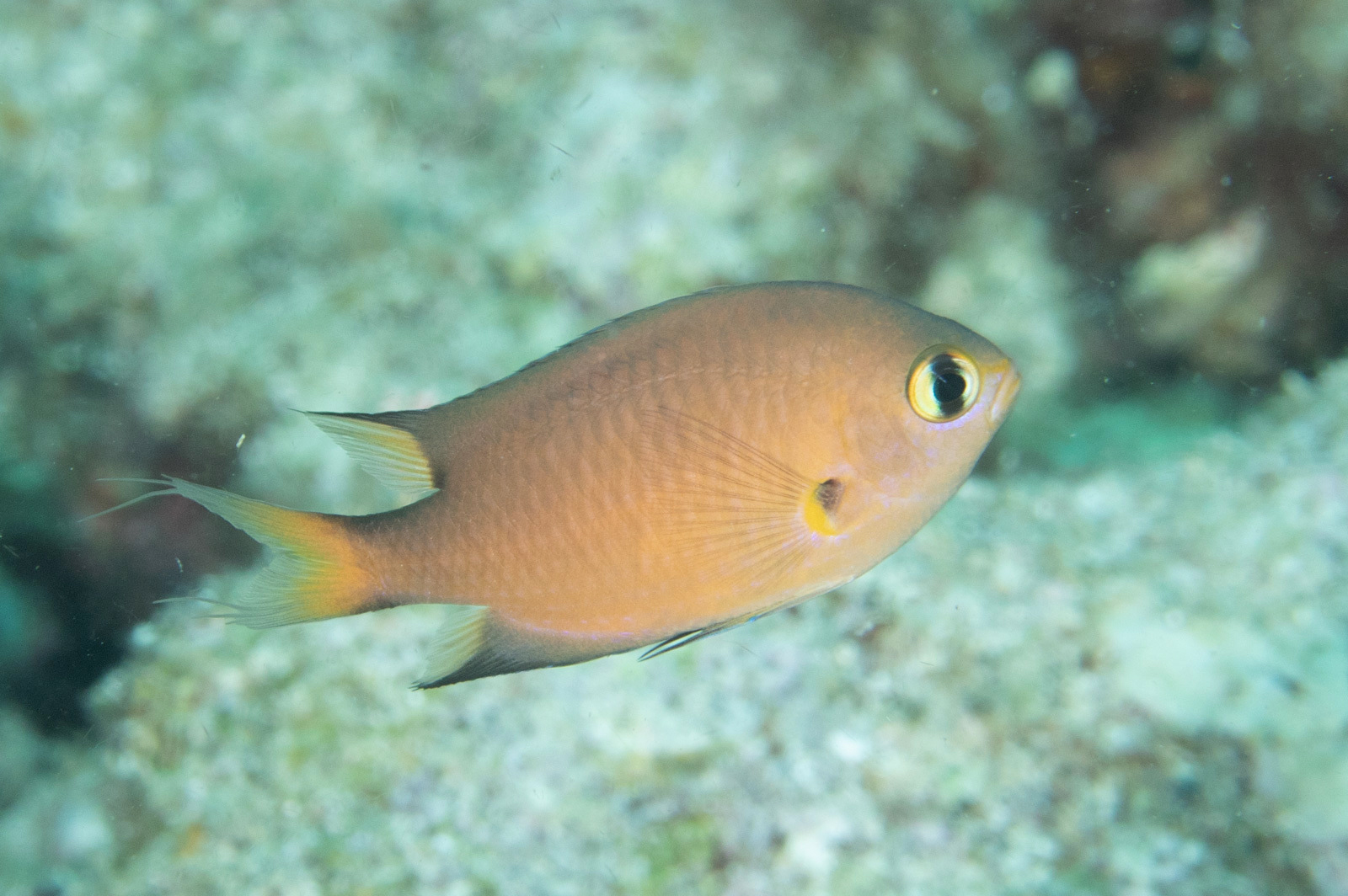Darkfin Puller, Chromis atripes Fowler & Bean 1928
Other Names: Darkfin Chromis, Dark-fin Chromis, Dusky Puller

A Darkfin Puller, Chromis atripes, at Karunju Island, Solomon Islands, April 2019. Source: Mark Rosenstein / iNaturalist.org. License: CC by Attribution-NonCommercial-ShareAlike
Summary:
A small orange-brown damselfish with a faint bluish to lavender sheen on the lower head and chest, a large eye with a black vertical bar and a yellow iris, a wedge-shaped black spot on the pectoral-fin base, and blackish upper and lower caudal-fin rays.
Cite this page as:
Bray, D.J. 2020, Chromis atripes in Fishes of Australia, accessed 01 Jul 2025, https://fishesofaustralia.net.au/Home/species/2311
Darkfin Puller, Chromis atripes Fowler & Bean 1928
More Info
|
Distribution |
Offshore reefs of north Western Australia, Ashmore Reef in the Timor Sea, and the far northern Great Barrier Reef and reefs in the Coral Sea, to the Capricorn-Bunker Group, Queensland; also Cocos (Keeling) Islands and Christmas Island in the eastern Indian Ocean, and the Lord Howe Province in the Tasman Sea. Elsewhere the species occurs in the tropical, east-Indo-west-central Pacific: Cocos (Keeling) Islands and Indonesia, east to the Marshall Islands and Fiji, north to southern Japan, south to northern Australia and New Caledonia. Individuals or small groups inhabit steep outer reef slopes, drop-offs and deeper patch reefs at depths to 35 m. |
|
Features |
Dorsal fin XII, 12-14; Anal fin II, 12-13; Pectoral fin 15-17; Lateral line scales 14-16; Gill rakers 24-29. Body depth 1.7-2.0 in SL. |
|
Feeding |
Feeds on zooplankton. |
|
Etymology |
The specific name atripes is from the Latin ater (= black) and pes (= foot) in reference to the black marking on the pectoral-fin base. |
|
Species Citation |
Chromis atripes Fowler & Bean 1928, Bulletin of the United States National Museum 100(7): 43, pl. 2. Type locality: Philippines. |
|
Author |
Bray, D.J. 2020 |
|
Resources |
Darkfin Puller, Chromis atripes Fowler & Bean 1928
References
Allen, G.R. 1975. Damselfishes of the South Seas. New Jersey : T.F.H. Publications 237 pp. 251 figs.
Allen, G.R. 1991. Damselfishes of the World. Melle, Germany : Mergus Verlag 271 pp.
Allen, G.R. 1993. Fishes of Ashmore Reef and Cartier Island. Records of the Western Australian Museum, Supplement 44: 67-91
Allen, G.R. 1997. Marine Fishes of Tropical Australia and South-east Asia. Perth : Western Australian Museum 292 pp. 106 pls.
Allen, G. R. 2001. Family Pomacentridae. pp. in Carpenter, K.E. & Niem, T.H. (eds). The Living Marine Resources of the Western Central Pacific. FAO Species Identification Guide for Fisheries Purposes. Rome : FAO Vol. 6 pp. 3381-4218.
Allen, G.R. & Smith-Vaniz, W.F. 1994. Fishes of Cocos (Keeling) Islands. Atoll Research Bulletin 412: 1-21
Allen, G.R. & Steene, R.C. 1988. Fishes of Christmas Island Indian Ocean. Christmas Island : Christmas Island Natural History Association 197 pp.
Allen, G.R., Steene, R.C. & Orchard, M. 2007. Fishes of Christmas Island. Christmas Island : Christmas Island Natural History Association 2 edn, 284 pp.
Fowler, H.W. & Bean, B.A. 1928. Contributions to the biology of the Philippine Archipelago and adjacent regions. The fishes of the families Pomacentridae, Labridae and Callyodontidae, collected by the United States Bureau of Fisheries Steamer Albatross, chiefly in Philippine seas and adjacent waters. Bulletin of the United States National Museum 100(7): 1-525 pls 1-49
Hobbs, J-P.A., Newman, S.J., Mitsopoulos, G.E.A., Travers, M.J., Skepper, C.L., Gilligan, J.J., Allen, G.R., Choat, H.J. & Ayling, A.M. 2014. Checklist and new records of Christmas Island fishes: the influence of isolation, biogeography and habitat availability on species abundance and community composition. Raffles Bulletin of Zoology Supplement 30: 184–202 https://lkcnhm.nus.edu.sg/rbz/supplement-no-30/
Hobbs, J-P.A., Newman, S .J., Mitsopoulos, G.E.A., Travers, M.J., Skepper, C.L., Gilligan, J.J., Allen, G.R., Choat, H.J. & Ayling, A.M. 2014. Fishes of the Cocos (Keeling) Islands: new records, community composition and biogeographic significance. Raffles Bulletin of Zoology Supplement 30: 203–219 https://lkcnhm.nus.edu.sg/rbz/supplement-no-30/
Hutchins, J.B. 2001. Biodiversity of shallow reef fish assemblages in Western Australia using a rapid censusing technique. Records of the Western Australian Museum 20: 247-270
Jenkins, A., Allen, G. & Yeeting, B. 2017. Chromis atripes. The IUCN Red List of Threatened Species 2017: e.T188430A1873575. https://dx.doi.org/10.2305/IUCN.UK.2017-2.RLTS.T188430A1873575.en. Downloaded on 08 August 2019.
Kuiter, R.H. 1992. Tropical Reef-Fishes of the Western Pacific, Indonesia and Adjacent Waters. Jakarta : PT Gramedia Pustaka Utama 314 pp. pls.
Randall, J.E. 2005. Reef and shore fishes of the South Pacific. New Caledonia to Tahiti and the Pitcairn Islands. Honolulu : University of Hawaii Press 707 pp.
Randall, J.E., Allen, G.R. & Steene, R. 1990. Fishes of the Great Barrier Reef and Coral Sea. Bathurst : Crawford House Press 507 pp. figs.
Randall, J.E., Allen, G.R. & Steene, R. 1997. Fishes of the Great Barrier Reef and Coral Sea. Bathurst : Crawford House Press 557 pp. figs.








